Brewery Trips
Triple Capital Trip Saturday 22nd September
 This year’s Brewery Trip (auctioned daily at the Great British Beer Festival) is returning to London and three people with lovely teams. We will start at 11am with Brockley Brewery, just a short walk from the Brockley Station. It came into existence in May 2013, set up by seven friends including two sets of husbands and wives. Most of the owners are local and the brewery is proud of being based in the community, sponsoring a number of local charity events and the owners are not afraid to muck in. It’s a 5 barrel plant so the smallest brewery of the day. The standard range is Golden, Pale Ale, Red and a lager. These are complemented by four seasonal beers. We are likely to be met by Jon, the head brewer, who used to brew at Lovibonds. For a fuller article see: Brockley.
This year’s Brewery Trip (auctioned daily at the Great British Beer Festival) is returning to London and three people with lovely teams. We will start at 11am with Brockley Brewery, just a short walk from the Brockley Station. It came into existence in May 2013, set up by seven friends including two sets of husbands and wives. Most of the owners are local and the brewery is proud of being based in the community, sponsoring a number of local charity events and the owners are not afraid to muck in. It’s a 5 barrel plant so the smallest brewery of the day. The standard range is Golden, Pale Ale, Red and a lager. These are complemented by four seasonal beers. We are likely to be met by Jon, the head brewer, who used to brew at Lovibonds. For a fuller article see: Brockley.
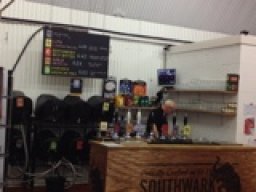 It’s then onto the train and up to Hackney Brewery based in a railway arch. They won the Champion Beer of London Award in March with their American Pale Ale. The team has grown substantially since setting up 2012 with a 6 barrel plant and just the founders, Jon and Pete, working from 4am to 10pm. Now, there are nine of them: the head brewer, Dan Walker, two other Brewers, two sales and two draymen. The kit is now three times as big with eight conical fermenters and they have moved into the premises next door. For more details on the brewery see: Hackney Brewery. We will have a snack here before going to our third brewery, Five Points.
It’s then onto the train and up to Hackney Brewery based in a railway arch. They won the Champion Beer of London Award in March with their American Pale Ale. The team has grown substantially since setting up 2012 with a 6 barrel plant and just the founders, Jon and Pete, working from 4am to 10pm. Now, there are nine of them: the head brewer, Dan Walker, two other Brewers, two sales and two draymen. The kit is now three times as big with eight conical fermenters and they have moved into the premises next door. For more details on the brewery see: Hackney Brewery. We will have a snack here before going to our third brewery, Five Points.
Five Points is one of those breweries that some people think have been around for a while but actually is less than six years old. Financed by three shareholders, it was established in an old black cab garage; the brewery is another that is cuddled up in a railway arch. But space has not prevented the brewery's growth with continual investment in areas such as conditioning/fermenting tanks, bottling, canning and cold storage. The brewery's reputation has grown and, with it, the need for change. Five Points now operates over a split site with the brewery in Hackney and a bigger warehouse and distribution centre down the road in Mare Street. Five Points produce a combination of real ale, keg, cans and bottled and their Pale has twice won the Champion Golden Ale of London twice. Recently, the beer also won silver in CAMRA’s London & SE Champion Golden Ale judging so a great way to finish a lovely day of beer! More details on Five Points can be found at: Pointing forwards. Like to join us? Places will be auctioned daily at the Great British Beer Festival but if you can’t get there, postal bids are accepted moc.tenretnitb@1591nitsuab(, 07789 900411).
Bristol bevvies
For many years, Bristol has been one of the leading cities for the growth of micro breweries so what better place to come for CAMRA's annual multiple Brewery trip, which is auctioned each year at the Great British Beer Festival.
 Despite the rain, it was an excursion to remember for the people who came from all over the country to taste Bristol's beer. The day started at Arbor Ales, where Jon Comer took us through the history of the Brewery. It started in 2007 in a shed at the back of a pub, the Old Tavern, Stapleton, run by his brother. At this stage it was a 2.5 barrel kit. The first move was to a 'walk in fridge' which was originally Brain's Faggot Factory. The kit was upgraded to a 5.5 barrel plant and Jon was still doing it mostly on his own. Demand for the beer continued to increase and so he needed to consider another expansion. Jon said 'The fridge didn't have enough space so we moved opposite the bus station in Lawrence Hill with 5 fermenters and we began brewing 5 days a week'.
Despite the rain, it was an excursion to remember for the people who came from all over the country to taste Bristol's beer. The day started at Arbor Ales, where Jon Comer took us through the history of the Brewery. It started in 2007 in a shed at the back of a pub, the Old Tavern, Stapleton, run by his brother. At this stage it was a 2.5 barrel kit. The first move was to a 'walk in fridge' which was originally Brain's Faggot Factory. The kit was upgraded to a 5.5 barrel plant and Jon was still doing it mostly on his own. Demand for the beer continued to increase and so he needed to consider another expansion. Jon said 'The fridge didn't have enough space so we moved opposite the bus station in Lawrence Hill with 5 fermenters and we began brewing 5 days a week'. 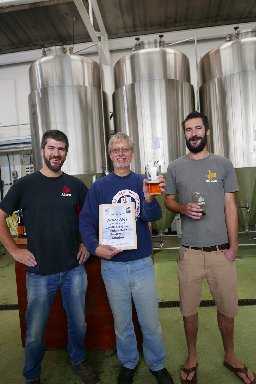
The final move was a couple of years ago to a disused bus depot nearby (Jon said 'that's enough moves!'). The site was built with a loan and help from the Regional Growth Fund. As well as the Brewery, Arbor now has a warehouse, although more work is needed to incorporate a proper bar, which is a medium term goal. 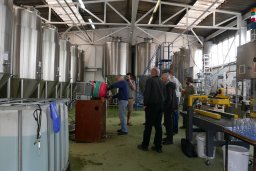
Like many brewers, much of the profits have been ploughed back into the brewery but Jon said they have expanded as much as they would like for the time being. The brew length has now increased to 20 barrels and includes six 20 barrel and two 40 barrel fermenters. Arbor is up to the maximum they can produce to keep the duty relief. Fortunately, the exported beer (which is around 15% of their sales) is excluded from this as is the beer they produce for M&S, who pay the beer tax. Italy, France, Sweden, Poland and even Singapore take Arbor beers.
Arbor is very much a family affair with John's wife selling the beer. They are assisted by 10 employees including the brewer, Dan Bell. They have a core range but Dan and Jon are 'allowed to play one day a week'. The mix is 50% cask with the rest split between keg and bottled, which is bottled conditioned.
The beers were a delight, from their well known Yakima Valley to some three year old bottled imperial stout. We could have stayed there all day but we ventured out into the rain to nearby Dawkins. 
 Glen Dawkins began his drinking days in Sheffield and, in particular, beer from the now closed Wards Brewery. He started working in an off license, Bottoms Up, with 120 different bottled beers and after finishing work each day, he would go and help at a local pub, the Hillsgrove Tavern. He eventually put his off license days behind him and took on the Miners Tavern, a big community pub with just one cask beer. Glen said 'I removed the smoothflow beers and put in more six handpumps'.
Glen Dawkins began his drinking days in Sheffield and, in particular, beer from the now closed Wards Brewery. He started working in an off license, Bottoms Up, with 120 different bottled beers and after finishing work each day, he would go and help at a local pub, the Hillsgrove Tavern. He eventually put his off license days behind him and took on the Miners Tavern, a big community pub with just one cask beer. Glen said 'I removed the smoothflow beers and put in more six handpumps'.
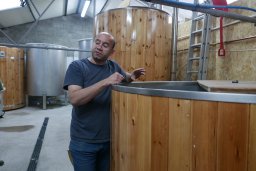 Glen then took over the Hillsgrove, which has now 14 hand pumps and more pubs followed. He now has five pubs across Bristol, predominantly Georgian, all leased and a new one, some distance away, Leith near Edinburgh!
'The pubs are always beer forward. More beer, provided it us in good nick, leads to selling more' he commented.
Glen then took over the Hillsgrove, which has now 14 hand pumps and more pubs followed. He now has five pubs across Bristol, predominantly Georgian, all leased and a new one, some distance away, Leith near Edinburgh!
'The pubs are always beer forward. More beer, provided it us in good nick, leads to selling more' he commented.
Having his own beer was the next thing on the horizon and, in 2010, Glen took over Matthews Brewing Co; a brewery originally set up in 2005 by Stuart Matthews and Sue Appleby in Timsbury, a few miles outside Bath. Glen explained 'Their beers were about a third of our sales. They decided they didn't want to expand so they sold up'.
The 'home brewed' beer, now renamed Dawkins, still accounts for about the same level of pub sales but the Brewery now does a range of bottled conditioned beers with outlets including the local Coop, off licenses and restaurants. Glenn thinks this will increase from the current 15% of sales. Keg is about 5% but Glenn has decided to think about the environment and uses Ecokeg rather than Key Keg. This means only the inner is replaced i.e. it is reusable. All of these beers are unfiltered and unpasteurised. ‘Maybe cans may materialise in due course' said Glen. The cask beers are not fined. Glen believes it takes the flavours out.
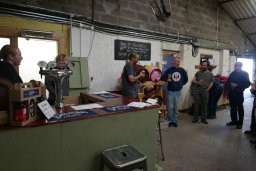 Interestingly, Palmers (wet) yeast is used in the majority of brews with dried yeast being used for a few others, particularly American style beers. Maris Otter is the main malt and the Brewery uses open fermenters, which are becoming less usual with 'trendy Brewers'. They also have their own mill for grinding their malt; unusual for a Brewery this size.
Interestingly, Palmers (wet) yeast is used in the majority of brews with dried yeast being used for a few others, particularly American style beers. Maris Otter is the main malt and the Brewery uses open fermenters, which are becoming less usual with 'trendy Brewers'. They also have their own mill for grinding their malt; unusual for a Brewery this size.
The Brewery has a tap room, it (and the Brewery) was open as part of Bristol's Open Doors weekend, re-enforcing Dawkins commitment to the local community. The success of the Brewery means now they employ six staff. Saying farewell to two of them, one of whom is heading up to run the Leith pub, we headed once again into the rain to Moor Beer Co.
Although there may be many American influenced breweries but what comes over with Moor is their commitment to balance and drinkability, perhaps the fact that the owner, Justin Hawkes, originates from the USA has something to do with it!
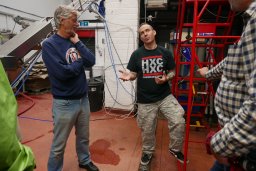 Moor has a 20 barrel brew length with 14 fermenters. Unlike many newer brewers, Moor uses whole hops rather than pellets and propagate their own yeast. All of the beer under goes a secondary fermentation, whether it is cask, can or Key Keg; their volume is evenly split between the three (they discontinued bottles). Moor was the first brewery in the UK to get their cans accredited as Real Ale, which Justin is justly proud of. As with all canning lines, this represented as major investment; their canning line can do 2500 cans per hour. Justin explained the rationale for the investment: 'Cans have the advantage in that, in comparison to bottles, they keep out the light'.
Moor has a 20 barrel brew length with 14 fermenters. Unlike many newer brewers, Moor uses whole hops rather than pellets and propagate their own yeast. All of the beer under goes a secondary fermentation, whether it is cask, can or Key Keg; their volume is evenly split between the three (they discontinued bottles). Moor was the first brewery in the UK to get their cans accredited as Real Ale, which Justin is justly proud of. As with all canning lines, this represented as major investment; their canning line can do 2500 cans per hour. Justin explained the rationale for the investment: 'Cans have the advantage in that, in comparison to bottles, they keep out the light'.
It is obvious that quality control is a key factor for Justin and another investment was their own lab where they propagate their yeast.
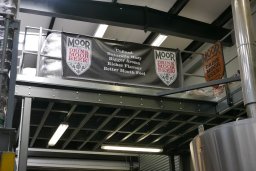 The history of Moor is an interesting one. Justin was an IT business consultant and also an ex USA army officer. He got into 'hazy' beer whilst in Germany. He started home brewing and joined CAMRA working at the Great British Beer Festival. He then moved from London to Somerset and bought the Moor Brewery, which had been started by a farmer. He started experimenting with recipes, commenting that, at the time, selling a beer with hops was hard 'We were ahead of our time. We love hops but it is all about balance and drinkability'.
The history of Moor is an interesting one. Justin was an IT business consultant and also an ex USA army officer. He got into 'hazy' beer whilst in Germany. He started home brewing and joined CAMRA working at the Great British Beer Festival. He then moved from London to Somerset and bought the Moor Brewery, which had been started by a farmer. He started experimenting with recipes, commenting that, at the time, selling a beer with hops was hard 'We were ahead of our time. We love hops but it is all about balance and drinkability'.
 Eventually, Justin and his wife moved the Brewery to Bristol and from there they haven't looked back. Moor now employ 20 people and run a successful brewery tap but like Arbor, Brexit is worry to their export trade with overseas representing a third on their turnover, Italy being the largest.
Eventually, Justin and his wife moved the Brewery to Bristol and from there they haven't looked back. Moor now employ 20 people and run a successful brewery tap but like Arbor, Brexit is worry to their export trade with overseas representing a third on their turnover, Italy being the largest.
Moor continue to plough a lot of the profit back into the Brewery (and the Tap). One surmises that real Ale in cans is but one of the innovations to come out of this Brewery!
To find out more about the breweries visited, visit their websites: http://arborales.co.uk/, www.dawkinsales.co, www.moorbeer.co.uk.
If this has intrigued you, in 2018, the three brewery visit will be in London.
Three more London Brewers!
 Historically, North London has not been known for its beer but, over the last few years. this has certainly changed.
Historically, North London has not been known for its beer but, over the last few years. this has certainly changed.
At the Great British Beer Festival, CAMRA' Games & Collectables auctioned off places on a triple brewery trip to breweries in N17 postcodes and it turned out to be a trip to remember.
Tottenham Hale was the first stop for a visit to the pristine Beavertown Brewery. Akin to many European breweries, with over 30 large sparkling fermenter/storage tanks, it has a techno image but anyone entering the brewery will see that this Is balanced by two figures painted on two of them, reminiscent of the graphic novels with equally energetic and vivid colours.
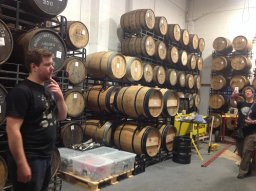 The brewery is a far cry from the tiny plant downstairs at Duke's Brew & Que. This was Logan Plant's reproduction of the many brew pubs he saw when visiting the States. A range of beers were tried at their from their regular Neck Oil and 8 Ball, all hosted by Kieran, who spoke about each with enthusiasm. All beers are keg but are unfined and unpasteurised; Beavertown do not do any bottles, concentrating on cans with distinctive graphics.
The brewery is a far cry from the tiny plant downstairs at Duke's Brew & Que. This was Logan Plant's reproduction of the many brew pubs he saw when visiting the States. A range of beers were tried at their from their regular Neck Oil and 8 Ball, all hosted by Kieran, who spoke about each with enthusiasm. All beers are keg but are unfined and unpasteurised; Beavertown do not do any bottles, concentrating on cans with distinctive graphics.
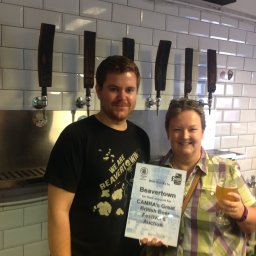 But the 'wow' factor was the 260 wooden barrels hidden in another warehouse, each with a different providence (whisky, bourbon, wine and sherry), potentially creating an amazing complexity of taste. To get the conditioning of the beer right they mix the aged beer with fresh beer. Many are collaborative brews.
But the 'wow' factor was the 260 wooden barrels hidden in another warehouse, each with a different providence (whisky, bourbon, wine and sherry), potentially creating an amazing complexity of taste. To get the conditioning of the beer right they mix the aged beer with fresh beer. Many are collaborative brews.
The visit can be best summed up with a comment from one of the party 'a real eye opener'. Beavertown's tap room is open at weekends see: http://www.beavertownbrewery.co.uk/
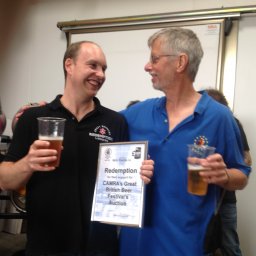 The next brewery was reached by a very wet walk due to a heavy downpour but the welcome received soon dried everyone up. Redemption was one of the early brewers that realised that London needed a greater variety of beers. Andy Moffat, the founder, is known as one of the nicest men involved in London brewing.
The next brewery was reached by a very wet walk due to a heavy downpour but the welcome received soon dried everyone up. Redemption was one of the early brewers that realised that London needed a greater variety of beers. Andy Moffat, the founder, is known as one of the nicest men involved in London brewing.
Their new brewery (they moved in early in 2016) has more of a traditional feel of a British brewery than Beavertown but it too is taking account of the changing market. Upstairs is a visitors centre and a meeting room that can be hired with all modern facilities. A classic example of a brewery looking for new income streams.
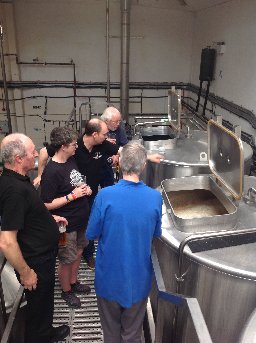 The new brewery has three 30 barrel fermenters and five 30 barrel conditioning tanks. With their commitment to quality, Redemption have invested in a large cold room. They are now brewing 2-3 times a week using a S&N yeast strain obtained from Brew Lab.
The new brewery has three 30 barrel fermenters and five 30 barrel conditioning tanks. With their commitment to quality, Redemption have invested in a large cold room. They are now brewing 2-3 times a week using a S&N yeast strain obtained from Brew Lab.
As well as cask, Redemption do bottled conditioned beers via South End Bottling (a collaboration between Ramsgate, Sambrook's and Westerham breweries) and they started to do the odd keg. The bottled beer is sterile filtered and then yeast added back. Andy says this gives extra character to the beer.
Consistency is the key for the brewery's future so they have a volunteer taste panel to help them (now there is a volunteer job!). And the future is important to Andy, Sam, his partner was also at the brewery to welcome the group and she was blooming with the next generation - maybe another brewer/brewster in the making?
The beers available on the day were all cask, from Trinity, one of my favourite lower alcohol beers (at 3%ABV) a refreshing blend of fruit and bitterness, to their award winning Fellowship Porter (named after the porters who unloaded the London ships), a complete contrast at 5.1% ABV.
For more information on the brewery and when the visitors centre will be open (they hadn't quite finished decorating at the time of the visit) see: http://www.redemptionbrewing.co.uk/
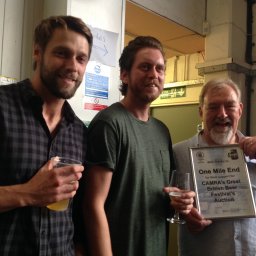 The last brewery of the day was the smallest, One Mile End, who had taken over Redemption's old 12 barrel brewery, just a short stroll around the corner. We were greeted by Simon and Andy. The brewery started at the White Hart in Mile End Road in 2014, thus its name. Sales had been going well so they decided to expand just at the time Redemption decided to move. It was also fortunate that Andy had brewed at Redemption and so he knew the plant. Along with the increased capacity, there is now an increase in staff to six including Ollie as an assistant brewer. In addition, they have decided to keep the small brewery for experimental brews but their regular beers are now brewed in Tottenham.
The last brewery of the day was the smallest, One Mile End, who had taken over Redemption's old 12 barrel brewery, just a short stroll around the corner. We were greeted by Simon and Andy. The brewery started at the White Hart in Mile End Road in 2014, thus its name. Sales had been going well so they decided to expand just at the time Redemption decided to move. It was also fortunate that Andy had brewed at Redemption and so he knew the plant. Along with the increased capacity, there is now an increase in staff to six including Ollie as an assistant brewer. In addition, they have decided to keep the small brewery for experimental brews but their regular beers are now brewed in Tottenham.
 One Mild End produce cask, keg and bottle. The core range is Dockers Delight, Snake Charmer IPA, Salvation and Hospital Porter. Unusually for London, between October and March, One Mile End also produce a mild called Great Tom (this was the name of the bell before Big Ben). Like Beavertown, they too are experimenting with aged beer but on a smaller scale with a few barrels maturing away at the back of the brewery. Look out for these in future and to find out more about their experimental reds, see: http://onemileend.com/.
One Mild End produce cask, keg and bottle. The core range is Dockers Delight, Snake Charmer IPA, Salvation and Hospital Porter. Unusually for London, between October and March, One Mile End also produce a mild called Great Tom (this was the name of the bell before Big Ben). Like Beavertown, they too are experimenting with aged beer but on a smaller scale with a few barrels maturing away at the back of the brewery. Look out for these in future and to find out more about their experimental reds, see: http://onemileend.com/.
Go through the history of brewing in one day!
Burton-on-Trent is famous for its brewing. CAMRA offered an opportunity to see three different breweries representing different times in the town's brewing history. This was for winners of the auctions at CAMRA's 2015 Great British Beer Festival, Games & Collectables auction, which took place each session.
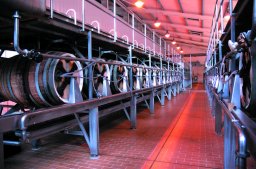 The trip started at Marston's, founded in Burton-On-Trent in 1834. Although, like many brewers, Marston's has modernised in a number of ways, it has proudly stuck to using the Burton
The trip started at Marston's, founded in Burton-On-Trent in 1834. Although, like many brewers, Marston's has modernised in a number of ways, it has proudly stuck to using the Burton 
Union System, a method of fermenting beer dating from the 1830's. It consists of a row of wood casks connected to a common trough by way of a series of pipes. This allow the excess yeast foam to be expelled from the casks and any beer that is expelled with the yeast is allowed back into the casks to continue fermentation. A visit to their fermenting room was a very memorable experience. http://www.marstonsbrewery.co.uk/[[fe59557b6207a60c17824debdfa6a277_26]]

The trip then moved to a newer micro brewery, Tower, reflecting the growth of new brewers over the last fifteen years. Tower is an excellent example of a brewery that has taken over an historic industrial building, preserved and given it a new lease of life. The brewery is on the site of Walsitch Maltings and the tower was built in the 1870s by Thomas Salt & Co Ltd. In 1927 was purchased by Bass. It was John Mills' vision to convert the building to a brewery, which opened in 2001 and the hard work was rewarded when John received a Civic Society award for the restoration of an industrial building. http://www.towerbrewery.co.uk/
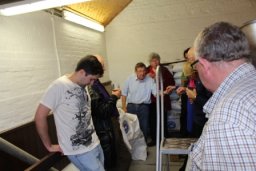
The final brewery visited is an example of a successful brewery set up in the first wave of new real ale brewers in the 1980's and one that kept going when others vanished! Burton Bridge Brewery now has five pubs in Burton-On-Trent including the Burton Bridge Inn, which won CAMRA's Best Conversion to Pub Use in 2001. The pub was built in the late 17th Century and was called the Fox and Goose. It still is one of the very few pubs to boast a traditional skittle alley.
The pub, which had been closed for a couple of years, was purchased by Geoff Mumford and Bruce Wilkinson in 1982 and a 15 barrel brewery was set up at the back of the pub and named after the nearby bridge. The brewery has won numerous awards over the years and is still experimenting. This year, it has brought out a Draft Burton Ale, a beer style that dates from the 18th century. See http://www.burtonbridgebrewery.co.uk/.
The trip will be on Saturday 19th September. Bidders will need to make their way to Marston's to start the day at 11.45am.
If you can't make it to the Festival to bid for either of these brewery experiences, postal bids are accepted. Contact Bill Austin 01923 211654 (answerphone) or moc.tenapus@nitsuab. For more details on both experiences, see: http://www.gandc.camra.org.uk/

The 2014 trip was to three brewery trip to some newer breweries in East London: Truman's, Crate and finishing at Tap East.
The trip took take place in September, starting at the Crate Brewery, near Hackney Wick overland station. Renown for its pizzas, the brew pub, where the this brewery started was designed to serve the artists and visitors to the London Olympics. the brewpub is housed in what was an old sweet factory, with high ceilings and an outside seating area by the canal. Demand grew so rapidly that a brew house(10 barrel plant) was opened nearby (almost next door) and a boat was purchased to provide additional seating and a stage for live music. But the brewing part of the brewpub lives on and is used for experimental brews. Crate brew at least four real ales regularly from their Golden at 3.8%ABV to their strong Stout at 5.7%ABV. See Not a wheel in sight!.
 A short walk, and we arrived at Truman's, a name always associated with brewing in the east end of London. The current owners of the brand tried for many years to purchase the Truman's name; they thought it strange that with so many pubs bearing the Truman's facade, the beer could not be found. Perseverance finally paid off and they started to test the market, by using a third party. After a couple of years, the owners finally took the plunge and set up a state of the art 20 barrel plant in an industrial unit. The Truman's Eagle emblem adorns the walls of the Eyrie Brewery (what else) and there are also a few pieces of original memorabilia. The first beer they brewed was a bitter, called Runner, which is now complemented by X other beers. For more information, see: Truman's Eagle nests in East London.
A short walk, and we arrived at Truman's, a name always associated with brewing in the east end of London. The current owners of the brand tried for many years to purchase the Truman's name; they thought it strange that with so many pubs bearing the Truman's facade, the beer could not be found. Perseverance finally paid off and they started to test the market, by using a third party. After a couple of years, the owners finally took the plunge and set up a state of the art 20 barrel plant in an industrial unit. The Truman's Eagle emblem adorns the walls of the Eyrie Brewery (what else) and there are also a few pieces of original memorabilia. The first beer they brewed was a bitter, called Runner, which is now complemented by X other beers. For more information, see: Truman's Eagle nests in East London.
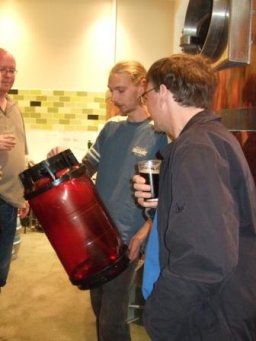 .After seeing the brewery, trying a few beers, we then retraced our steps to Hackney Wick Station to board the train to Stratford where we visited a brewpub built into the shopping centre, Tap East. This pub brewery was set up, like Crate, to cater for the Olympic visitors but now provides a welcome haven for shoppers who like a good beer. Close to the station, its reputation for its ales, means that a visit to the pub is an easy and worthwhile trip for most London drinkers. We popped behind the glass wall at the back of the pub where the tiny, but perfectly formed, brewery is based. And of course, we tried some of their delectable beers including one of their best sellers, Coffee in the Morning, a lovely black porter with coffee from a shop also based in the shopping centre - so supporting local retailers. See Tapping the East.
For the full article, see: Triple London Brewery Trip 2014.
.After seeing the brewery, trying a few beers, we then retraced our steps to Hackney Wick Station to board the train to Stratford where we visited a brewpub built into the shopping centre, Tap East. This pub brewery was set up, like Crate, to cater for the Olympic visitors but now provides a welcome haven for shoppers who like a good beer. Close to the station, its reputation for its ales, means that a visit to the pub is an easy and worthwhile trip for most London drinkers. We popped behind the glass wall at the back of the pub where the tiny, but perfectly formed, brewery is based. And of course, we tried some of their delectable beers including one of their best sellers, Coffee in the Morning, a lovely black porter with coffee from a shop also based in the shopping centre - so supporting local retailers. See Tapping the East.
For the full article, see: Triple London Brewery Trip 2014.

In 2013, the trip was to two breweries in the heartland of British hops, Kent.
Starting at the Shepherd Neame Brewery, to see a family brewery whose history can be traced back to 1678, when Richard Marsh, once mayor of Faversham, leased the brewery, eventually buying it two decades later.
Although old, Shepherd Neame have not been resting on their laurels. Their micro brewery has been gaining itself a growing reputation with a steady stream of unusual beers. But Shepherd Neame remain proud of their past and have recently started producing beers from their C19th brewers' logs. So proud were they of their recipes, even at that time, that the recipes were originally written in a cipher to avoid their being copied and taken to rival breweries.
After a trip around the brewery, some beer (of course) and a spot of lunch, the group left Faversham heading south east by train to the historic town of Canterbury.  Here the group visited Canterbury Brewers, a microbrewery based within the city walls of Canterbury, in sight of the Cathedral. It is just two years old but their premises are rather older. The brewery, pub and restaurant are in a stunning building known as the Foundry. This was part of the Drury & Biggleston's Foundry, which from the early 1800's to the late 1900's supplied the South East Railway and constructed one of the very first torpedoes. It comes as no surprise then that their debut brews were Foundryman's Gold and Foundry Torpedo.
Here the group visited Canterbury Brewers, a microbrewery based within the city walls of Canterbury, in sight of the Cathedral. It is just two years old but their premises are rather older. The brewery, pub and restaurant are in a stunning building known as the Foundry. This was part of the Drury & Biggleston's Foundry, which from the early 1800's to the late 1900's supplied the South East Railway and constructed one of the very first torpedoes. It comes as no surprise then that their debut brews were Foundryman's Gold and Foundry Torpedo.
Previous trips have included Hop Back and Downton, Hepworth and Downton, Elgoods and Sambrook, Brew Wharf and Kernel.
